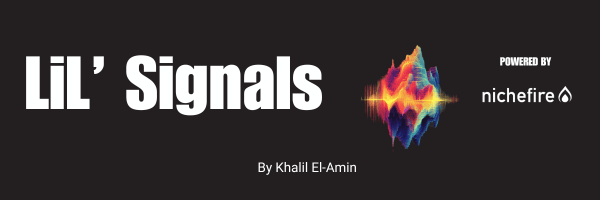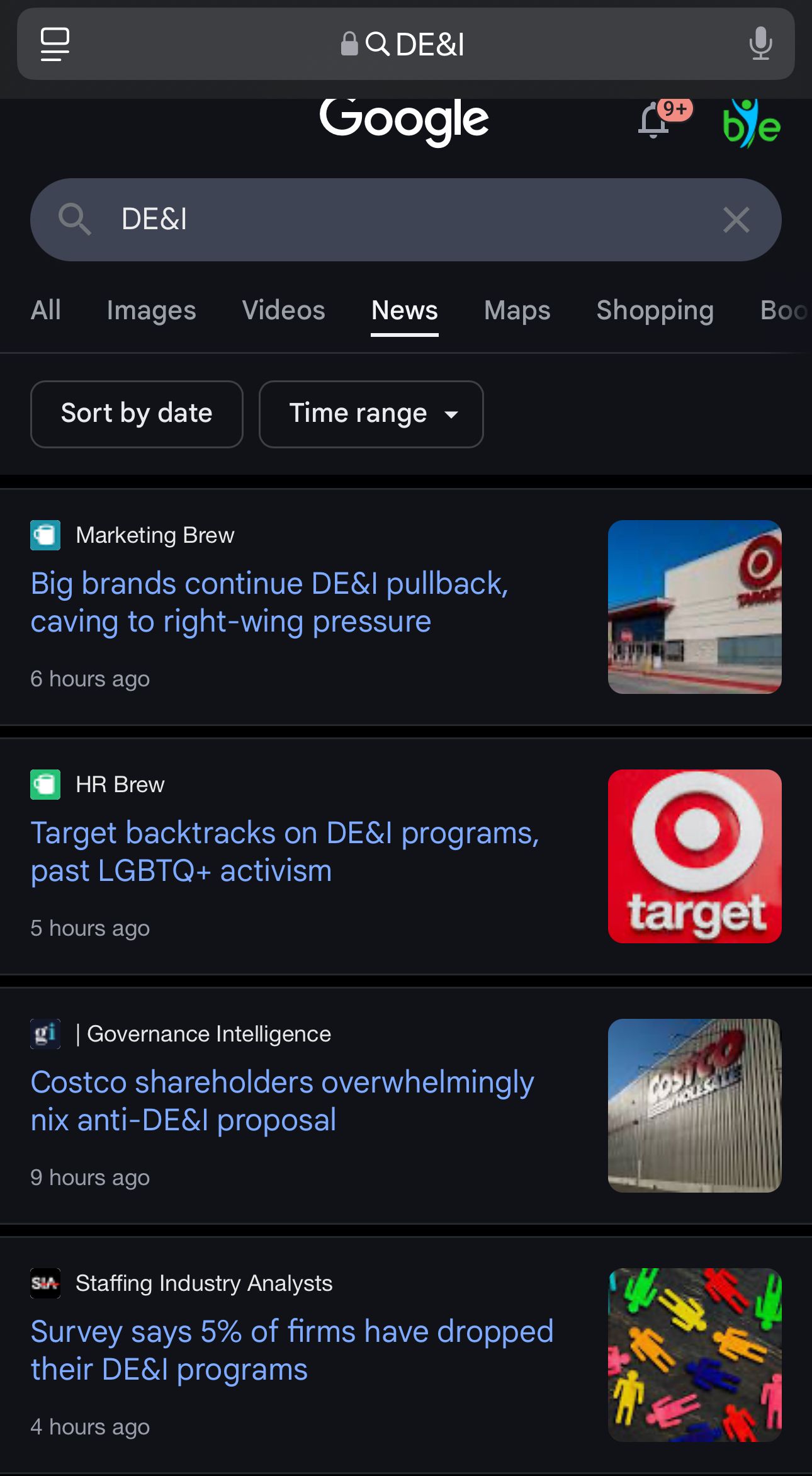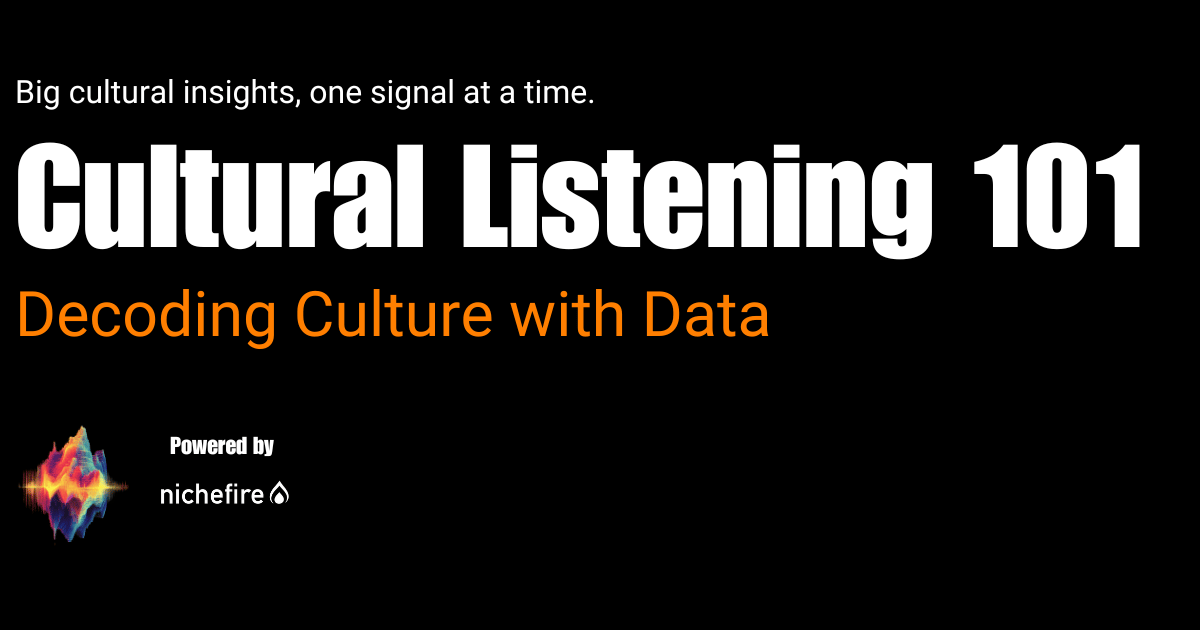- Lil' Signals
- Posts
- Lil’ Signals: As DE&I Retreats, AI Reshapes the Game
Lil’ Signals: As DE&I Retreats, AI Reshapes the Game
The corporate DE&I pullback is real—but AI is stepping in as the new force reshaping opportunity, competition, and the future of work.

👋🏽 Hey There
Lil’ Signals is your go-to newsletter for decoding the cultural currents shaping our world.
Powered by Nichefire’s cutting-edge technology, we break down trends, tell compelling stories, and share actionable insights on how to tap into the power of cultural listening.
Stay ahead of the curve—one signal at a time.
Lil’ Signals drops every Wednesday morning! Today, we’re unpacking the corporate pullback on DE&I and how AI is stepping in to reshape opportunity, competition, and the future of work.
Let’s dive in!!
Table of Contents

StoryTime
DE&I Meets AI: A Tale of Two Shifts in 2025

Diversity, Equity, and Inclusion (DE&I) has been a hot topic in America, but 2025 is shaping up to be the year when the narrative pivots.
While conversations about equity remain relevant, the spotlight has shifted toward a new player on the global stage: artificial intelligence.
From corporate diversity programs to breakthroughs in the AI race between the U.S. and China, these dual shifts signal profound changes in how we define opportunity and competition.
For decades, DE&I initiatives sought to correct systemic inequities in the workplace.
These efforts opened doors for underrepresented groups, as I witnessed firsthand when my father’s business flourished through programs like MBE (Minority Business Enterprise) certifications.
Yet, in 2025, we’re seeing a retreat from corporate DE&I commitments, with companies like Target and Walmart scaling back diversity programs.

The rollback is disappointing, especially for those who saw these initiatives as a way to level the playing field in industries long dominated by exclusivity.
But while the emotional weight of these changes is undeniable, we must resist getting lost in the politics and focus instead on the broader landscape.
The truth is, DE&I isn’t disappearing—it’s evolving.
In an era where AI has emerged as the ultimate disruptor, the conversation must shift toward leveraging technology as the great equalizer.
In 2015, Michael Howard, Steven Brown, made the bold decision to shut down our digital agency and launch Nichefire, an AI company we’re proud to lead today.
At the time, the technology wasn’t as widely understood or adopted as it is today, but we recognized its transformative potential.
We believed that when AI reached the masses, it would revolutionize how Fortune 500 companies operate, giving them unprecedented tools to enhance efficiency, decision-making, and leadership.
For me, as a Black man, I saw AI as the ultimate equalizer—a way to level the playing field and create opportunities that hadn’t existed before.
And it has paid off tremendously.
By focusing on AI’s ability to improve human workflows, I’ve seen firsthand how this technology can open doors not just for businesses but for individuals like me who are willing to stay ahead of the curve.
But this journey doesn’t end here.
I’m committed to continuing to learn everything I can about AI models and applications that enhance productivity.
And by focusing on key leaders within Fortune 500 companies, we can drive widespread adoption across industries.
It’s not just about staying relevant; it’s about staying indispensable.
As DE&I conversations recede in corporate boardrooms, a global arms race in artificial intelligence is dominating headlines.
The U.S. has long held a technological edge in AI, boasting leading companies like OpenAI, Google, and Microsoft.
However, China is rapidly closing the gap, fueled by state-sponsored research, efficient innovation, and companies like DeepSeek, which recently unveiled an AI model that rivals the best in the West while using fewer resources.
In January 2025, DeepSeek shocked the tech world by releasing an AI model that matched or exceeded the capabilities of OpenAI’s GPT while requiring significantly less computational power.
This breakthrough sent NVIDIA’s stock plummeting by 17%, wiping out $560 billion in market value (Sheesh)
Investors and tech leaders alike are reeling, questioning whether the U.S. can maintain its dominance in a field increasingly defined by efficiency and adaptability.
Key Factors in the Race:
Efficiency vs. Resources: DeepSeek’s ability to achieve high performance with fewer chips challenges the hardware-driven growth model of U.S. tech giants.
Open-Source Momentum: While U.S. companies lean toward proprietary systems, China’s embrace of open-source AI could accelerate global adoption.
Government Support: China’s centralized planning and strategic funding give it an edge in rapid deployment, especially in emerging markets.
What This Means for Individuals: A Call to Action
Whether you’re reflecting on the rollback of DE&I programs or the geopolitical implications of the AI race, one thing is clear: the future belongs to those who can adapt.
The workplace of tomorrow won’t care about your race, gender, or background as much as it will value your ability to harness AI to solve problems and drive innovation.
Here’s how to prepare:
Master AI Tools: Familiarize yourself with platforms like ChatGPT, MidJourney, and other emerging tools. Understand not just how they work but how to apply them to your role.
Stay Ahead of Trends: Learn the newest prompts, APIs, and automation techniques. Be the person on your team who introduces cutting-edge solutions.
Showcase AI Skills on Resumes: Frame your knowledge as a competitive advantage. Highlight how you’ve used AI to improve efficiency, solve challenges, or create new opportunities.
Adopt a Growth Mindset: AI tools aren’t here to replace jobs—they’re here to enhance the people who know how to use them. Stay curious, stay informed, and stay adaptable.
The Bigger Picture: DE&I and AI Converge
While it may seem like the rollback of DE&I programs is a step backward, the rise of AI offers a chance to reframe the conversation.
In many ways, AI is becoming the new equalizer, providing tools that anyone—regardless of background—can use to excel.
It’s no longer just about leveling the playing field; it’s about empowering individuals to create their own opportunities in a rapidly changing world.
Let this be your battle cry.
Learn the tools, master the strategies, and position yourself as a leader in the age of intelligence.
Stay curious. Stay connected. Stay ahead.
I’m excited to have you here and look forward to hearing your thoughts, suggestions, or questions.
Let’s explore the power of culture, one signal at a time.

Cultural Listening 101

Cultural Listening 101: Understanding the Discovery Page
Welcome to Cultural Listening 101, where we break down how to track, analyze, and decode cultural trends in real-time. Today, we’re diving into the Discovery Page, a powerful tool for keeping your finger on the pulse of culture.
What is the Discovery Page?
Think of the Discovery Page as your 10,000-foot view of cultural trends—it’s the ultimate dashboard that provides real-time insights into what’s happening across industries, communities, and platforms.
It’s powered by Nichefire’s default dataset, which is an AI-driven model trained across 40+ categories and subcategories. This means that whether you’re tracking food and beverage, retail trends, or emerging conversations in tech, the Discovery Page surfaces the most relevant and influential cultural signals.
For example, let's say you’re monitoring food and beverage trends. The Discovery Page will highlight top trends, breaking stories, and discussions shaping that space—from viral product launches to shifts in consumer sentiment.
Navigating the Trends: From Macro to Micro
Once you land on the Discovery Page, you’ll see a live feed of trending topics. Each trend is linked to a network of related conversations, helping you understand not just what’s trending, but why it’s trending.
Here’s how you can dig deeper:
FireSearch™ Integration: Clicking on a trend takes you to FireSearch™, Nichefire’s large language model, which pulls from millions of data points across social media, news, forums, and other sources.
Trend Clustering: Each trend is connected to sub-trends that give context to the broader conversation.
Real-Time Sentiment & Impact: AI-powered analysis determines how people feel about the trend—whether it’s positive, negative, or polarizing.
Example: The Costco x Pepsi Switch
A recent trend that caught attention was Costco’s switch from Pepsi. By clicking into the Discovery Page, you could immediately see how this decision sparked massive conversations:
Consumer Reactions: Some celebrated the move, while others were upset about losing their favorite drink options.
Cultural Context: Costco’s stance on DEI (Diversity, Equity, and Inclusion) initiatives was also trending, raising discussions on whether these issues were connected.
Competitor Insights: Brands like Walmart and Sam’s Club were also mentioned in related conversations.
By following these layers, you move beyond surface-level headlines and uncover the underlying forces shaping consumer behavior.
The Dashboard: Quantifying Trends
For those who love data-driven insights, the dashboard offers granular trend analysis:
✅ Volume Metrics – How many people are discussing the trend?
✅ Engagement Scores – Are these conversations gaining traction?
✅ Platform Breakdown – Where is the conversation happening (Twitter, Reddit, news articles, etc.)?
Want to go even further? Click into the Explorer View, where you can interact with data visualizations, charts, and audience demographics.
AI-Powered Trend Analysis
One of the biggest pain points in cultural research is manually sifting through thousands of posts. That’s where AI-powered tools like Cultural Listening GPTs come in.
Here’s how it works:
Instead of scrolling through 900+ Reddit comments, ask the AI to summarize key themes.
Filter insights based on positive vs. negative sentiment.
Quickly extract top 100 takeaways without spending hours reading.
By automating the grunt work, you can focus on strategic storytelling, brand positioning, and actionable insights.
Why Cultural Listening Matters
At its core, cultural listening isn’t just about spotting trends—it’s about understanding what they mean, why they matter, and how to act on them.
With real-time monitoring, AI-assisted analysis, and deep-dive trend insights, the Discovery Page enables you to:
🚀 Identify trends early before they go mainstream.
🎯 Understand the “why” behind consumer behaviors.
📊 Make data-backed decisions to drive marketing and innovation.
This has been another lesson in Cultural Listening 101. Stay curious, stay ahead, and see you next week!
Thank you for subscribing to Lil’ Signals.
If you enjoyed this post or know someone who may find it useful, please share it with them and encourage them to subscribe: https://lilsignals.beehiiv.com/p/lil-signals-decoding-culture-one-insight-at-a-time?draft=true

Content Engines
I want to see what YOU can create.
Got a cool AI-generated video?
A creative experiment?
A bold idea?
Share it with us!
Reply to this email with your best creations, and let’s see who’s leading the AI content revolution. 📤✨

Top Cultural Trends
Stay Ahead with Nichefire
In this new section, we’re diving into Nichefire’s unique tools to explore the top cultural trends shaping our world.
This week, we break down key insights from the Movements Matrix, spotlighting high-growth and emerging trends across 47 cultural categories
Spot Emerging Trends: Discover niche opportunities before they hit the mainstream.
Actionable Insights: Leverage cultural data to make faster, smarter decisions.
Comprehensive View: Analyze trends across 47 pre-trained cultural categories.
Lil’ Surfing 🌊
Just interesting articles I find on “The Internets” 😜

💬 Your journey into the world of cultural insights starts here!
Thank you for being part of the Lil’ Signals community. Together, we’ll decode the world, one signal at a time.
Reply